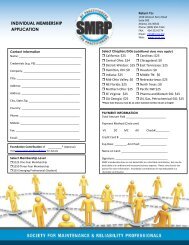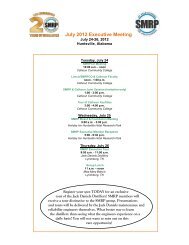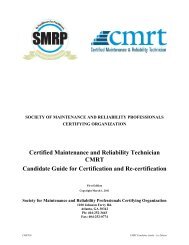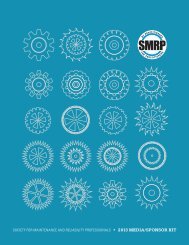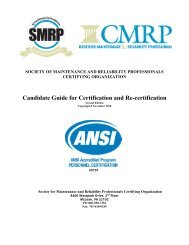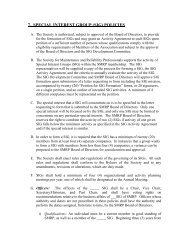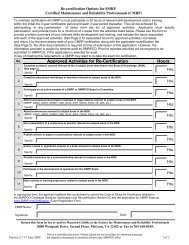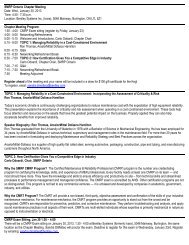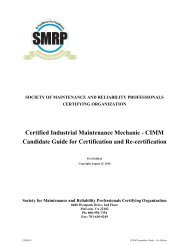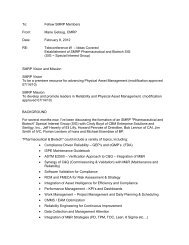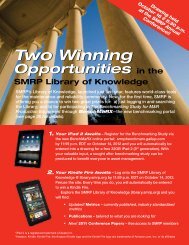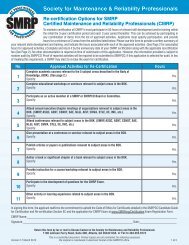conference brochure - Society for Maintenance & Reliability ...
conference brochure - Society for Maintenance & Reliability ...
conference brochure - Society for Maintenance & Reliability ...
- No tags were found...
You also want an ePaper? Increase the reach of your titles
YUMPU automatically turns print PDFs into web optimized ePapers that Google loves.
WorkshopsWorkshop #1Leadership Characteristics ofSuccessful <strong>Maintenance</strong> and <strong>Reliability</strong>OrganizationsPaul Casto, Meridium, Inc.Monday, October 15, 20128:00 a.m. – 5:00 p.m.Visionary Leadership is a distinguishing characteristic ofsuccessful <strong>Reliability</strong> and <strong>Maintenance</strong> organizations andinitiatives. Today’s leaders are dealing with the loss of theircritical knowledge base to retirement, a constant drive to reducecosts, capital expenses, and risk to lives and the environment –while managing their corporate image.In this business environment, it takes <strong>for</strong>ward-thinkingleaders to understand the need to develop their peoplewhile defining and developing processes that are effectiveand impact improvement. Business as usual worked whenthese factors weren’t in play. Today’s leaders are driven tochange management, organizational integration, improvingwork processes, stakeholder management, building strongerinterdepartmental relationships, and instilling sustainability intothe fabric of the organization.This workshop will discuss these aspects of R&M leadershipas well as developing metrics to measure progress, rewardsystems to foster the right behaviors, determine how toimprove the probability of success, and be able to buildand communicate the business case and basic elements ofleadership.Workshop #2Bringing Your <strong>Maintenance</strong> KPIs to theCorporate LevelTerry Wireman, VestaPartners, LLCMonday, October 15, 20128:00 a.m. – 5:00 p.m.In today’s competitive business climate, companies are being<strong>for</strong>ced to seek every conceivable advantage to succeed byimplementing quality improvement initiatives, empowering workteams, reorganizing internally, contracting out work, optimizingassets, etc. However, these improvement ef<strong>for</strong>ts rarely focuson the maintenance function, since this function frequently doesnot have KPIs (Key Per<strong>for</strong>mance Indicators) that are understoodor connected to corporate-level KPIs.To date, few companies have been able to effectively managemaintenance, primarily due to the lack of proper businessdevelopment <strong>for</strong> the maintenance function. Without a properunderstanding of the maintenance business function, companiescannot develop proper KPIs and have them understood at thecorporate level. Since the maintenance department and staffhave a significant impact on the condition, and ultimately, thecapacity of costly manufacturing, process, and other capitalizedassets, there is a clear need to develop a maintenance businessand then a KPI system that is effective at all levels from the shopfloor to the corporate boardroom.This workshop will also be a working session to allowattendees to select one of four typical corporate indicators andsuccessfully link the maintenance indicators to them through thevarious KPI levels. All attendees should leave with an enhancedunderstanding of developing per<strong>for</strong>mance measures and waysof presenting them to their corporate managers.Workshop #3Lessons from NASCAR TM Race Teams’Pursuit of 100% <strong>Reliability</strong>Robert Williamson, Strategic Work Systems, Inc.Monday, October 15, 20128:00 a.m. – 5:00 p.m.Zero breakdowns, zero accidents, and zero defects at peakper<strong>for</strong>mance in a highly competitive marketplace may seem likeunrealistic goals, but in NASCAR TM racing these are the essentialfoundations <strong>for</strong> winning. Top race teams must develop andsustain work cultures that abhor waste and inefficiency, thrive oncontinuous improvement, and pursue 100% equipment reliabilityof their critical equipment: The race car. Anything less results infailure to compete and ultimately failure of the business venture.Failure is not an option.NASCAR TM race team methods, especially at the Cup level,are the ultimate in competitive motorsports and can serve as amodel <strong>for</strong> any capital-intensive business. When you discoverhow they put their common sense principles into practice, themodel <strong>for</strong> industry becomes very clear and compelling. Toprace teams use the principles of leadership and teamwork, leanmanufacturing, reliability-centered maintenance, total productivemaintenance, theory of constraints, strategic policy deployment,and regulatory compliance to achieve success. But you wouldbe hard-pressed to hear the buzzwords or see the “programs”commonly found in businessindustry.Participants in this workshopwill see Six Key Principlesapplied to race cars fromdesign to build, throughroutine operations andmaintenance, and see howthese proven techniquesare truly common senseand adaptable to capitalintensiveindustries whilehighlighting industrialequipment applicationsand work cultures.7
WorkshopsWorkshop #4Value Stream Mapping <strong>for</strong> <strong>Maintenance</strong>Ed Stanek, Jr., LAI <strong>Reliability</strong>Monday, October 15, 20128:00 a.m. – 5:00 p.m.As maintenance and reliability professionals, how can we findtime to improve reliability with growing backlogs and restrictivemaintenance budgets? The answers can be found in identifyingand removing waste in our systems and what is considered “justthe way it is” blending into the background.Workshop attendees will learn how to apply Value StreamMapping (VSM), as well as other LEAN tools to theirmaintenance processes to create awareness, identify valueaddedsteps, and eliminate Muda (or waste). This will includethe Lean <strong>Maintenance</strong> Model, the Value Stream Mappingprocess <strong>for</strong> <strong>Maintenance</strong>, Types 1 and 2 Muda (Waste), and OME(the OEE of maintenance), and other LEAN tools <strong>for</strong> removingwaste in your maintenance program and processes.Bring your own data to this hands-on workshop. LAI will alsoconduct a Web session preceding this workshop and provideall attendees with a workbook to collect sample data to be usedduring the workshop.Workshop #5Improving Machinery Assembly,Installation Per<strong>for</strong>mance & <strong>Reliability</strong>Ian McKinnon, <strong>Reliability</strong> Solutions TrainingMonday, October 15, 20128:00 a.m. – 5:00 p.m.During a recent conversation, a high-level manager asked,“Why is it that with all of the investments in technology we’vemade, we still have the same type of failures in the same ornear same cycles?” How is it that we fail to recognize the valueof asset improvements to reliability, production enhancement,manufacturing cost, and energy conservation with correctapplication of on-the-floor skill sets? We need to consider how“mechanical” failures can be much more than just mechanicalcraft issues, and how these failures also include electrical,instrumentation, production, engineering, purchasing, and othergroups.compiled data “pareto” results. Attendees will realize the needto place high importance on improving our on-the-floor skill setsto further reduce costs, improve reliability, and positively impactbusiness competitiveness in achieving “Reliable Manufacturing.”Everyone from senior managers, superintendents, and engineersto craft technicians are encouraged to attend and increase theirunderstanding of machinery assembly and installation essentials.Workshop #6Results-Oriented <strong>Reliability</strong> &<strong>Maintenance</strong> Management 2012Christer Idhammar, IDCON, Inc.Monday, October 15, 20128:00 a.m. – 5:00 p.m.In the arena of maintenance management, there aremany common improvement opportunities and obstaclesto overcome. In this workshop, we will discuss commonmaintenance definitions and concepts, define reliability and howto measure and value reliability, and uncover how time is used inpoor, good, and great maintenance organizations.There are many reasons why the multiple reliability improvementinitiatives do not deliver the projected results, but there areenablers to overcome this. Best practices <strong>for</strong> the maintenancesystem, processes, and elements will be discussed along withhow to create a reliability culture. This reliability culture mustinclude a partnership and work system between Operations,<strong>Maintenance</strong>, Engineering, and Stores.Finally, there are many Key Per<strong>for</strong>mance Indicators out there<strong>for</strong> organizations to use, but not all of them are useful andsome of them are quite useless. Indicators must drive and trulyshow results. They must define the gap between how goodyou are and how good you can become. In other words, withoptimization of maintenance, how do you do that, and is therean optimum? By developing a reliability and maintenancestrategy, a measurable vision and mission, and an action plan,your organization can reach where you want and need to be.To gain the best value from this workshop, it is highlyrecommended that you participate with a team including youroperations & maintenance managers, front line supervisors &leaders, planners, and crafts people.We will take a brief glimpse into how we as maintenance &reliability professionals continue to concentrate on technologiesto find failures with little to no emphasis on real and measurableasset improvement. We will build an awareness that includes“improvement and precision-based” activities with historical“failure-based” ef<strong>for</strong>ts to better recognize, reduce, and manageasset failures to achieve higher manufacturing gains.This session features live dynamic machine sets that plainlydemonstrate how to move to and achieve “best-in-class” runningper<strong>for</strong>mance utilizing precision techniques in the elimination offailure sources. Attendees will receive a field checklist to recordobservations at their facilities, which will receive a review of8
Workshop #7Revisiting <strong>Reliability</strong>-Centered<strong>Maintenance</strong> Basics – What Did Nowlanand Heap Have to Say?William R. Steele, Management Resources Group, Inc.Monday, October 15, 20128:00 a.m. – 5:00 p.m.<strong>Reliability</strong>-Centered <strong>Maintenance</strong> (RCM) is the process used toidentify the most effective maintenance approach <strong>for</strong> systems andequipment. This workshop will examine RCM process elementsand relate them to the original material developed by the airlineindustry as documented in the book authored by F. Stanley Nowlanand Howard F. Heap (almost 35 years ago). One of the objectivesidentified by the airline industry was to develop scheduledmaintenance programs that assured the maximum safety andreliability of equipment at the lowest cost. This is an objective thatstands to this day in most industrial settings.For a person just getting started in the maintenance and reliabilityfield, this workshop will provide you with a clear understandingof <strong>Reliability</strong>-Centered <strong>Maintenance</strong>, its process steps, and theexpected outcomes. For experienced maintenance & reliabilityprofessionals, this workshop will refresh the topic and illustrate howwell the original work has stood the test of time.Topics to be presented and discussed include: The elements ofRCM, the role of Failure Modes and Effects Analysis (FMEA), the SAEstandard and various approaches to RCM, condition monitoring andpredictive technologies, maintenance task selection, analysis teamdevelopment, and measuring implementation effectiveness.Workshop #9What a <strong>Reliability</strong> EngineerNeeds to KnowHeinz Bloch, Process Machinery ConsultingMonday, October 15, 20128:00 a.m. – 12:00 p.m.This workshop is <strong>for</strong> the professional reliability engineerwho is interested in improving his/her plant and professionalgrowth. The topics explored will cover advanced best practices<strong>for</strong> particular commonly-used machinery, such as pumps,compressors, and motors. In addition, Best of Class proceduresand practical tips will be explored <strong>for</strong> the following questions:• What does a reliability engineer have to know?• How does he/she acquire this knowledge?• Who pays <strong>for</strong> training of a professional?• Does training end at the facility’s main gate?• Where does the reliability engineer stand in the organizationand to whom does he/she report?• Role statements, training plans, and weekly listing of workrecord---why they are needed.Workshop #8Design <strong>for</strong> <strong>Reliability</strong>Mike Poland, Life Cycle EngineeringMonday, October 15, 20128:00 a.m. – 5:00 p.m.Ninety-five percent of the total life cycle cost of a new asset,system or process is determined during design. In thisworkshop, you’ll explore the principles of Life Cycle AssetManagement, a holistic approach that addresses not onlyinfrastructure needs, but also the supporting people, businessprocesses, data, and enabling techniques that are critical tosuccess. You’ll also learn how to minimize life cycle cost anddecrease risk in the major stages of a facility’s life cycle concept,design, construction, commissioning, certification, production,decommissioning, and disposal. In essence, during this workshopyou will learn how to design <strong>for</strong> reliability.The learning objectives of this workshop include: Describingthe role, methods, and significance of designing <strong>for</strong> reliability,implementing a checklist of design <strong>for</strong> reliability considerations,describing the concepts of life cycle asset management, life cyclecost, and asset management, per<strong>for</strong>ming a design simplifiedfailure modes and effects analysis (DSFMEA), and incorporatinghuman factor considerations in safety and reliability.9
WorkshopsWorkshop #10<strong>Maintenance</strong> Management 101/201Bruce Hawkins, Management Resources Group, Inc.Monday, October 15, 20128:00 a.m. – 5:00 p.m.Much has been written about advanced reliability and strategiesand tools such as RCM, TPM, Predictive Technologies, and EAMSystems. Many books and articles illustrating their successfulimplementation appear every day. Indeed, they are some of themost valuable tools an organization can use to advance downthe road to a proactive reliability culture.For these tools to be of maximum value, the organization mustbe ready to use them effectively. Like a farmer preparing his/her fields by tilling and fertilizing, the organization must bearmed with some fundamental philosophies and values so theseadvanced concepts can take root. Without these fundamentals,an organization has the potential to invest significant resourcesinto one or more of these tools and receive little sustainablebenefit.These fundamental philosophies can only come from themaintenance & reliability leader. This individual must set the rightexpectations and rein<strong>for</strong>ce these through the correct behaviors<strong>for</strong> the organization to develop the necessary discipline toeffectively use the tools. Un<strong>for</strong>tunately, there is no “primer” that amaintenance manager can turn to where these philosophies areexplained.Most effective managers learn these fundamentals througha good mentor or through experience – the school of “hardknocks.” So what if you don’t have a mentor and can’t af<strong>for</strong>d tomake the mistakes necessary to gain experience? Not to worry,this workshop will explore several of the most important lessonsthat a maintenance & reliability leader must learn to create thefoundation <strong>for</strong> a proactive maintenance culture.Workshop #11Leading the Per<strong>for</strong>mance CultureTrans<strong>for</strong>mationBrad Peterson & Ian Hedding, SAMIare often unsustainable because the culture did not embraceand adopt the new methods, tools, and processes by exhibitingthe required behaviors.This workshop will go through a detailed summary of thePer<strong>for</strong>mance Culture, as well as the philosophy and methodsthat are used in creating this type of organization. Significanttime will be spent discussing the 4 Ps of the Per<strong>for</strong>manceCulture: Predictability, per<strong>for</strong>mance, people, and purpose.In addition to these domains that drive sustainable businessper<strong>for</strong>mance improvements, the workshop presenters willdive deeper into the supporting elements of each of the 4Ps, to provide a detailed understanding of the core drivers ofbehavioral and cultural change.We will review specific case studies, as well as our article“Creating the Per<strong>for</strong>mance Culture,” which outlines SAMI’sthought leadership behind the quantification of cultural change.Graphical models will be used to support the discussion ofcultural trans<strong>for</strong>mation, with a be<strong>for</strong>e-and-after look into areactive culture turned Per<strong>for</strong>mance Culture.Workshop #12<strong>Maintenance</strong> Planning & SchedulingDoc Palmer, Richard Palmer and AssociatesMonday, October 15, 20128:00 a.m. – 5:00 p.m.<strong>Maintenance</strong> planning and scheduling should dramaticallyimprove the productivity of maintenance. For example, agroup of 30 maintenance technicians should be per<strong>for</strong>ming thework of 47 persons when aided by a single planner. Yet mostmaintenance organizations do not have a planning functionand most that do are frustrated. The author of McGraw-Hill’s<strong>Maintenance</strong> Planning and Scheduling Handbook, Doc Palmer,reviews the fundamentals and then leads class exercises toillustrate the principles and techniques to achieve success.This workshop not only covers the theory and vision, but alsothe nuts and bolts of how planning and scheduling work. Thisworkshop allows class participants to take specific practiceshome to their own organizations. Participants should be able toimplement a new planning organization or dramatically improvean existing planning organization.Monday, October 15, 20128:00 a.m. – 5:00 p.m.Most organizations are good at developing detailed businessprocesses, building task lists, and creating requirements <strong>for</strong>measuring per<strong>for</strong>mance in one way or another. We oftensee companies track financial and functional per<strong>for</strong>mance,but seldom find companies who define, quantify, and trackbehavioral and/or cultural per<strong>for</strong>mance. When a companydoesn’t execute the steps to define the specific behaviors thatwill drive cultural trans<strong>for</strong>mation, any improvement initiativethe company undertakes is up against systemic culturalresistance. In many cases, these initiatives truly fail but aredeclared successes. This isn’t a new concept, but rather anacknowledged fact: Benefits associated improvement initiatives10
Workshop #13CMMS: The Road to Success –Everything from Selection toImplementation and BeyondMike Barok & Gene Pargas, eMaint Enterprises, LLCMonday, October 15, 20128:00 a.m. – 5:00 p.m.A CMMS implementation is not a final destination: It’s the startof a journey. A successful implementation process starts withidentifying goals and business objectives, planning the scopeof the project, assembling an implementation team, selecting asoftware plat<strong>for</strong>m, and preparing to “Go-Live.”But that’s only part of the story. A CMMS is a company asset.In order to achieve the fullest return on this asset, we have toconsider the entire lifecycle that starts with pre-implementationplanning, system selection, training, and “Going Live” while alsomeasuring results, adjusting goals, and incorporating ongoingcontinuous improvement projects.A step-by-step outline of the team, the tools, the processes, andthe metrics that need to be considered in order to achieve notonly initial results but also to sustain continuous improvementwill be provided.This is more than a “strategy” session. The presenters will besharing detailed real-world examples drawn from both personalexperience in maintenance leadership, as well as from hundredsof successful implementations. This workshop will provideyou with valuable lessons, whether you are planning a CMMSimplementation or wish to expand or revitalize your existingmaintenance program regardless of your industry or your CMMSsoftware.Workshop #14Strategic Planning <strong>for</strong> <strong>Maintenance</strong> &<strong>Reliability</strong> LeadersGreg Folts & Tracy Strawn, Marshall InstituteThursday, October 18, 20128:00 a.m. – 5:00 p.m.Strategic planning is a leadership discipline and managementprocess that allows an organization to define its strategyand organizational direction, including decision making <strong>for</strong>allocating and assigning resources to execute the strategy.In short, strategic planning is a disciplined ef<strong>for</strong>t to producefundamental decisions and actions that shape and guide whatan organization is, what it does, and why it does it, with a focuson the future.This workshop will review the key elements of strategic planningand how it applies to the maintenance organization. It will alsocover the 8 step strategic planning process and the planninghierarchy of long-term planning, mid-term planning, and shorttermplanning.In addition, we will discuss the steps necessary to establishshort-term and long-term goals to achieve organizationalsuccess. Participants will leave this workshop with the abilityto apply strategic planning practices learned in the class backto their facility. This workshop will be valuable <strong>for</strong> maintenancemanagers, maintenance supervisors, manufacturing managers,reliability engineers, reliability managers, plant managers,continuous improvement managers, and TPM coordinators.Workshop #15SMRP Best Practices Metrics WorkshopBruce Hawkins, SMRP Best Practices Committee ChairManagement Resources Group, Inc.Thursday, October 18, 20128:00 a.m. – 5:00 p.m.The SMRP Best Practices Metrics Workshop provides trainingand practice in the calculation and understanding of theindicators <strong>for</strong> measuring maintenance, reliability, and availabilityper<strong>for</strong>mance. The indicators are the metrics being developedby the SMRP Best Practices Committee.The objectives <strong>for</strong> the workshop are:• To increase the understanding of benchmarking andharmonized maintenance indicators; and• disseminate knowledge and share best practices.The benefits <strong>for</strong> the participants are:• To obtain a better understanding of the terminology anddefinitions in maintenance;• understand the indicators and how to improve theper<strong>for</strong>mance measured by the indicators/metrics;• compare their current maintenance per<strong>for</strong>mance with that ofothers;• communicate maintenance per<strong>for</strong>mance improvement tomanagement and maintenance staff;• support business strategies with pre-defined goals;• highlight areas of best per<strong>for</strong>mance; and• share experience in KPI tracking and to network with others.At the workshop, participants have the opportunity to calculatea number of key per<strong>for</strong>mance indicators (KPIs), such asmaintenance cost, maintenance manhours, and availabilityper<strong>for</strong>mance that drive per<strong>for</strong>mance. Each participant willreceive a workbook, answer sheet, and metrics booklet.Participants are divided into teams of three to six individuals andper<strong>for</strong>m calculations on a case-study company. The results arepresented by each team and discussed as a group.11
WorkshopsWorkshop #16<strong>Maintenance</strong> Business ExperienceRemco Jonker, Erwin Hessels, & John HolmesMainnovation, Inc.Thursday, October 18, 20128:00 a.m. – 5:00 p.m.Discover the treasure in maintenance. In an increasinglycompetitive market, maintenance organizations are requiredto improve their business per<strong>for</strong>mance by creating more value;contributing to the overall company results. Fortunately, manymaintenance organizations contain a value potential that has notyet been realized. But where is this treasure hidden and howcan it be revealed?That’s where the <strong>Maintenance</strong> Business Experience comes in.The <strong>Maintenance</strong> Business Experience is an interactive businessgame <strong>for</strong> maintenance and reliability professionals. Variousmaintenance teams compete with each other to develop themost value adding maintenance strategy <strong>for</strong> a fictive companycalled Evolve. In the annual strategy assessment, the teams arefaced with questions like: How many technicians do we need,how many critical spare parts should we have on stock, what isthe optimum preventative maintenance <strong>for</strong> this plant, and whichimprovements should we implement in our organization? Eachyear a benchmark report is provided to the teams to see howtheir strategy has influenced their per<strong>for</strong>mance and what needsto be done to further improve. The team that has created thehighest economic value after four budget years wins the MostValuable <strong>Maintenance</strong> Award.What do you learn? In this unique event, participants learnhow to steer maintenance using Key Per<strong>for</strong>mance Indicators,benchmarking data and maintenance best practices like RCM,TPM, and RBI. The <strong>Maintenance</strong> Business Experience is basedon Value Driven <strong>Maintenance</strong> (VDM), a leading managementmethodology that helps companies to maximize the economicadded value of maintenance. During the game, various showcases are presented of companies who improved the economicvalue of maintenance significantly.Workshop #17Operator-Driven <strong>Reliability</strong> – Preservingand Growing Your Investment inProcesses and PeopleDave Staples, SKFThursday, October 18, 20128:00 a.m. – 12:00 p.m.Operators are rapidly accepting an active role in preventive andpredictive maintenance. This process, called Operator-Driven<strong>Reliability</strong> (ODR), is best enabled by implementing technologyto automate task management, quality, and tracking in eachoperator’s hands. The best Operator-Driven <strong>Reliability</strong> programsovercome corporate resistance to change and continuallydemonstrate on-going productivity.Our ODR community has found best practices to implement andsustain their program’s per<strong>for</strong>mance. Produce quick results andmaximize your ODR success with a sound implementation plan,built to last, grow, and continually improve. This workshop willshare the ODR community’s real life experiences, best practices,and tools to overcome program stalls and common pitfalls.Participants of this workshop will walk away with a workingknowledge of the following topics: Assessing current operatormaintenance and reliability practices, customizing an ODRprogram that meets your business goals and operatorcapabilities, implementing best practices and sustaining ODRprograms, and dealing with culture change associated withODR.Workshop #18Lubrication ExcellenceTerry Harris, Reliable Process SolutionsThursday, October 18, 20128:00 a.m. – 5:00 p.m.This is not just another program to tell you how much and howoften! Lubrication Excellence is a must <strong>for</strong> any manufacturingprocess. This workshop teaches how lubrication of equipmentis one of the most important functions in any plant process. Itis important because we want our equipment to operate invery long cycles without failing. Lubricating oils and greaseshave over 50 failure modes that we have control over. Storage,filtration, temperature, and moisture are just a few that will becovered.Lubrication programs have over 50 failure modes in themethods we use <strong>for</strong> ordering, receiving, storing, andtransporting our lubricants around the plant. LubricationExcellence will guide you in the steps needed to change yourprogram and put you on the path <strong>for</strong> extending equipment lifeby three to eight times what you are presently experiencing.Participants should include operations managers, maintenancemanagers, maintenance personnel, plant lubrication technicians,and Contractors in charge of plant lubrication activities.Participants will receive the following to take back to their plantsto start their programs: A binder with all slides and charts, 100failure modes of lubricants and lubrication programs document,RPS Lubrication Manual, and Oil Analysis handbook.This program is a must <strong>for</strong> plants looking to improve theirequipment lifecycles and a great start <strong>for</strong> any reliability program.Many plants have seen excellent results from developing theseprograms at their facilities.12
Workshop #19Evaluating and Optimizing Your CurrentPM Program “TODAY”Ricky Smith, GPAlliedThursday, October 18, 2012 & Friday, October 19, 20128:00 a.m. – 5:00 p.m. each dayDoes your staff per<strong>for</strong>m Preventive <strong>Maintenance</strong> (PM) onequipment that continues to fail? If your facility or organizationsuffers from this problem, this workshop will help eliminateunnecessary PM tasks and improve your plant’s per<strong>for</strong>mance.By the end of this workshop, you will know how to evaluate yourPM’s and measure their effectiveness, as well as how to modifythem if required. These tasks are a requirement <strong>for</strong> ensuring acontinuous improvement process is in place <strong>for</strong> your PM Program.Topics taught in this workshop include:• What are failure modes and how do you identify them?• What is the P-F Curve and how does it correlate with your PMProgram?• How is a PM Evaluation conducted, step-by-step?• How is a PM optimized to ensure it is repeatable and effective?• How is the effectiveness of a PM Program measured byequipment, area, and plant or site?This workshop will change your life by changing the way youview and manage PM in your organization. Additionally, sincethis workshop deals directly with existing PMs from your facility,you will leave with actionable items that can be implementedupon your return. Due to the interactive nature of thisworkshop, bring 100-200 PM tasks in Excel, an open mind, and apartner/team from your company to change your PMs.You will take home a complete PM Evaluation <strong>for</strong> the PM tasksthat you bring to the <strong>conference</strong>, a PM template that can beused at your site to optimize your PM Program, new PMs thatwere rewritten from your existing PM tasks to ensure they areeffective, and a <strong>Maintenance</strong> Metrics Dashboard that is used todetermine if your PMs are effective.Workshop #20Executive Level <strong>Maintenance</strong> & <strong>Reliability</strong>Best Practices OverviewRamesh Gulati, Aerospace Testing AllianceLynn Moran, Co-Speaker, Aerospace Testing AllianceThursday, October 18, 20128:00 a.m. – 5:00 p.m.Fundamentals of maintenance & reliability best practices will becovered during this workshop. These fundamentals include:• Introduction to asset management and its business impact;• reliability culture examples;• defining best practices and asset per<strong>for</strong>mance;• understanding maintenance and its new role;• workflow and roles;• planning & scheduling;• materials management;• optimizing maintenance (<strong>Reliability</strong>-Centered <strong>Maintenance</strong>(RCM) and Condition Based <strong>Maintenance</strong> (CBM));• operations role;• workplace design – 5S+;• designing <strong>for</strong> RAMS (reliability, availability, maintainability, safety);• improvement tools (6 Sigma tools, CMMS/EAM);• work<strong>for</strong>ce/people development, including communication;• asset management and standards (PAS 55, ISO 5500X, and…);• current trends (lean, energy, and green initiatives, includingsustainability);• sustaining a reliability and safety culture; and• managing change and continuous improvement.Workshop #21Preparing Your Organization <strong>for</strong> ChangeDarrin Wikoff, GPAlliedThursday, October 18, 20128:00 a.m. – 5:00 p.m.The path to reliability improvement is riddled with obstacles.As your organization begins to implement tactical solutionsto maintenance and reliability problems, you will inevitablyencounter resistance to change. Resistance is a natural partof the transition from reactive to proactive, but if unmanaged,can reduce the probability of successful implementation. Yourreturn on investment is contingent upon institutionalizing newpractices and new behaviors in support of maintenance andreliability fundamentals. Studies conducted over the past tenyears indicate that as much as 60% of the identified ROI is at riskif organizational change management is not sufficiently definedwithin the improvement plan.This workshop is designed to help participants recognize therisk of change and develop a change management strategy tomitigate the risk. Participants will walk away with a fundamentalunderstanding of the individual change process, a template<strong>for</strong> risk evaluation, a change management outline, and thepotential pitfalls associated with work management, materialsmanagement, and asset health management.13
WorkshopsWorkshop #22Work Management SimulationEd Stanek, Jr., LAI <strong>Reliability</strong>Thursday, October 18, 20128:00 a.m. – 5:00 p.m.The Work Management Simulation TM is one of the mostinnovative training systems available today. The Simulation is atremendous awareness tool as it deals with every undesirablemaintenance and reliability problem. Then, through a systematicapplication of best practices timed around the theory ofconstraint management, it elevates productivity and reliability bydriving out the seven wastes.Whether you are looking to elevate or create your planning &scheduling ef<strong>for</strong>ts, learn planning & scheduling optimizationthrough the Work Management Simulation TM , an innovative,interactive means to transfer the many concepts of maintenancework management best practices.Participants will see firsthand the negative effects of “doingwhat we’ve always done” in a typical reactive maintenanceenvironment. From round-by-round analysis, teams makeincremental improvements in the way maintenance work isidentified, planned, and scheduled, showing the considerableincrease in work accomplished between every round not byworking faster but by managing the waste around the job. Thissimulation goes far beyond showing the importance of proactivemaintenance in the pursuit of reliability; it goes on to show theparticipants how it is attained.Workshop #23Leaning Out Your Energy ControlProgram (LOTO)John Perrotti, Fuss & O’Neill Manufacturing Solutions, LLC& Doc Palmer, Richard Palmer and AssociatesThursday, October 18, 20128:00 a.m. – 12:00 p.m.This workshop is meant to discuss the OSHA standard <strong>for</strong> anEnergy Control Program, commonly referred to as Lock Out/TagOut (LOTO). It will cover the requirements <strong>for</strong> using LOTO duringservice and maintenance operations.Safety is an essential part of the productive work<strong>for</strong>ce.Understanding the different types of LOTO that can be used willbe demonstrated, as well as methods and techniques that canbe used to reduce the amount of steps necessary to comply.Case examples will be shown to demonstrate that with certainmachine improvements, LOTO is no longer required <strong>for</strong> certainmaintenance functions. Lean methodologies will be addressedthrough the use of visuals <strong>for</strong> machine specific procedures.The differences in LOTO <strong>for</strong> servicing and maintenance as wellas LOTO <strong>for</strong> electrical work will be explained in detail as this iscurrently the emphasis <strong>for</strong> OSHA.The target audience <strong>for</strong> this presentation is the VP ofmanufacturing, facility managers, maintenance managers,production and maintenance supervisors, reliability engineers,as well as safety and quality professionals. This audience willcome away from this workshop with tools and techniques thatwill help them to per<strong>for</strong>m improved and more consistent energycontrol and will also satisfy a portion of the regulatory trainingrequirements set <strong>for</strong>th by OSHA.Workshop #24Managing your MRO Storeroom Using“Best Practices”Jim Davis, Per<strong>for</strong>mance Consulting Associates (PCA)Thursday, October 18, 20128:00 a.m. – 12:00 p.m.Creating “The Perfect MRO Storeroom”…Is it Possible? Yourcompany may be losing much needed equipment uptimedue to repair parts shortages, losses, and misidentificationand mishandling, which greatly impacts the maintenancedepartment’s ability to get needed repair work done efficientlyand effectively.Is it possible to reduce maintenance material costs whileimproving asset per<strong>for</strong>mance?Do your storerooms look more like the average family garagerather than a place <strong>for</strong> conducting efficient business?The answer to these challenges may lie in creating theperfect MRO storeroom. This workshop will focus on thebasics, as well as some of the specifics <strong>for</strong> this initiative. Asa part of our discussion, we will go into some detail <strong>for</strong> thefollowing “key” areas or elements of efficient and effectivestoreroom operations: Analyze, design, mobilize, operate,measure, optimize, and sustain. We will learn how to applyindustry-proven MRO “best practices” within a company’sMRO storeroom or spare parts warehouse. We will cover thebasics of “best practice” operations and discover the differencebetween just “running a storeroom” versus “managing astoreroom.”This workshop is designed <strong>for</strong> the MRO storeroom manager,storeroom supervisor, or senior storeroom attendant, but can bevaluable to any maintenance & reliability professional.14
ExhibitorsExhibit Hall FeaturesSMRP Annual Conference features a full exhibit hall showcasingthe latest products, services and technologies from maintenanceand reliability business partners.• See the latest in public safety technology.• Hear new product announcements.• Visit all of your vendors in one location.• Do some comparison shopping.• Seek solutions and find new technologies.• Talk with others who are using or considering a product orservice you are researching.The Exhibit Hall opens Monday night with the Welcome Reception.Tuesday and Wednesday’s breakfasts, lunches andall breaks will be held in the Exhibit Hall. See below <strong>for</strong> who isexhibiting and be sure to visit them and learn how their solutionscan benefit your company.Exhibit HoursMonday, October 15 – 6:30 to 9:00 p.m.Tuesday, October 16 – 9:15 a.m. to 7:00 p.m.Wednesday, October 17 – 7:00 a.m. to 2:00 p.m.To reserve a booth or receive sponsorship in<strong>for</strong>mation, pleasecall 678-303-3039 or e-mail Sandy Stevens atSStevens@kellencompany.com.ExhibitorsBoothNumberExhibitorsBoothNumberExhibitorsBoothNumberABB Inc. 609Hydrotex 605Per<strong>for</strong>mance Consulting Association 601ABS Consulting 304IDCON, Inc. 406Polaris Laboratories 302Allied <strong>Reliability</strong> 201/300Infraspection Institute 600Predictive Service 409/508All-Test Pro, LLC 504Isograph, Inc 400R&G Laboratories 200Azima DLI 205/207Ivara Corporation 506<strong>Reliability</strong> Management Group 303Brunson Instrument Company 701/703Life Cycle Engineering 408<strong>Reliability</strong> Solutions 405/407Carver PA Corporation 404Lubrication Engineers 208SAMI 209/308CTC - Vibration Analysis Hardware 203Ludeca Inc 500Scientech 306Day + Zimmermann 206<strong>Maintenance</strong> Techonology/Lubrication <strong>Maintenance</strong> Techonology101SD Myers 503Delta Technologies 704Management Resources Group,Inc (MRG)501SDT Ultrasound Solutions 502Des-Case Corporation 305Marshall Institute, Inc. 607SKF USA Inc. 307/309Doble Engineering Company 103Meggitt Sensing Systems 603SMRPTBDDreisilker Electric Motors 604Meridium 301Test Products International 702Emerson Process Management 202Mobius Institute 606TEZZCO Inc. 210GPAllied 507/509Noria Corporation 107The Mundy Companies 401Henkel Corporation 700PdMA Corporation 608UE Systems 403Honeywell 505People and Processes, Inc. 402Vibrant Technology 60215
Track sessionsDateTimeTrack 1(BusinessManagement)Track 2(ManufacturingProcess)Track 3(Equipment<strong>Reliability</strong>)Track 4(Organization &Leadership)Track 5(Work Management)Track 6(CMRT)Track LeadersTrack Chair:Carl SchultzCMRP, eMaintEnterprises, LLCSessionLevels:(B) -Beginner(I) -Intermediate(A) -AdvancedJohn Holmes,CMRP, MainnovationScott Bruni, CMRP, MRGSteve Leach, CMRPChevronJason Price, CMRPIndependentMark Callahan,CMRP, PfizerRick Larson, CMRPAramarkJohn Johannemann,CMRP, Ascend MaterialsBill Chambers, CMRPDuPontTim Holmes, CMRPDuPontEric Bevevino, CMRPValvolineDavid Skarupa, CMRPATSNick Roberts, CMRPDuPontDoc Palmer, CMRPRichard Palmer &AssociatesJohn Pearl, CMRPMoose & AssociatesJohn Barker, CMRPJeffrey Taylor,TimkenRonnie Skipworth,CMRP, AerospaceTraining AllianceTuesday, October 169:45 a.m.-10:45 a.m.11:15 a.m.- 12:15 p.m.1:30 -2:30 p.m.3:00 -4:00 p.m.4:30 -5:30 p.m.Working Effectivelywith YourIT Department (A)Presenter:Cindy BoydCBM EnterpriseSolutionsA Method to Measureand Drive ImprovedUse of a CMMS (I)Presenter:Mark ScottVesta Partners LLCISO 55000 – Takingthe Fun and ExcitementOut of AssetManagement (I)Presenter:Marc LaplanteMeridium, Inc.Co-Presenter:Scott MorrisGenzyme CorporationDiscover the SecretValue of <strong>Maintenance</strong>(I)Presenter:Remco JonkerMainnovation Inc<strong>Maintenance</strong> and<strong>Reliability</strong> PracticesEmployed by BestPer<strong>for</strong>ming Companies(A)Presenter:Al Poling, CMRPSolomon AssociatesThe Role of Operationsin the <strong>Reliability</strong>Journey (I)Presenter:Stephen Bollman,CMRPJacobs TechnologyCo-Presenter:Michael McNulty,CMRP, CMRTLiebherr MiningBeyond Down Time (A)Presenter:Clint Grafelman,CMRPRio TintoNine Years ofSustained <strong>Reliability</strong>and Culture Changeat Alcoa WarrickSmelter (I)Presenter:Mark Keneipp, CMRPAlcoa, Inc.,Warrick OperationsCo-Presenter:Randy HeislerLife Cycle EngineeringLeveraging <strong>Reliability</strong>Operations Modelto Drive Success atOwens Corning (A)Presenter:Tony Dotson, CMRPOwens CorningHow to Create a Safeand Effective Electrical<strong>Maintenance</strong>Program (I)Presenter:Martin Robinson,CMRP, IRISSCo-Presenter:Mike Doherty, IHSAElectrical Bondingand GroundingCritical to OperationsExcellence (A)Presenter:H. Landis “Lanny”Floyd II, PE, CSP,CMRP, Fellow IEEEDuPontNew API-691: “Riskbased Life CycleManagement <strong>for</strong>Machineries” (A)Presenter:Cesar Malpica, CMRPChevronCo-Presenter:Boris BarriosGenesis Oil and GasShaft Current on MVof non-VFD motors:Generation, Detection,Consequenceand Mitigation (I)Presenter:MIchael IfurungHolcim US -Ste. Genevieve PlantSynergy BetweenMethodology andTechnology toImprove System <strong>Reliability</strong>(I)Presenter:Sridhar RamakrishnanSuncor Energy Inc.Co-Presenter:Saigopal VisvanathanSuncor Energy Inc.<strong>Reliability</strong> at theMicro Level (I)Presenter:Josh Toliver, CMRPPfizerClosing the SkillsGap from Within:Redesigning TechnicalDevelopmentPrograms (I)Presenter:Mark Schmid, CMRPHonda of AmericaManufacturing Inc.Co-Presenter:Scot McLemoreHonda of AmericaManufacturing Inc.A Leadership CompetencyModel toDrive <strong>Maintenance</strong> &<strong>Reliability</strong> Improvements(A)Presenter:Paul Henry, CMRPARAMARK FacilityServicesCo-Presenter:William HughstonARAMARK FacilityServices<strong>Reliability</strong> CentricOrganizations (I)Presenter:Craig Cotter, CMRPHESSShould Reactive<strong>Maintenance</strong> Jobs beRecorded as Near-Misses? (I)Presenter:Perry LovelaceJohn M. Campbell & Co.Practical <strong>Reliability</strong> -5 year <strong>Reliability</strong> Planat Agrium KapuskasingPhosphateOperations (A)Presenter:Chris Jones, CMRPAgriumSuccessful OutagePlanning Process (I)Presenter:Gary Smith, CMRPMomentive SpecialtyChemicalsThe Basics of Safe<strong>Maintenance</strong> (I)Presenter:Wim VancauwenbergheBEMAS - Belgium<strong>Maintenance</strong> AssociationUsing 4 Week LookAhead Forecasting toDrive Improvementsin Plant Operationsand <strong>Maintenance</strong> (I)Presenter:Jay Padesky, CMRPUS Gypsum Co.<strong>Maintenance</strong> PlanCalibrations (I)Presenter:Stephen Cooper,CMRP, JEASystematic FailureHistory CapturingThrough SAP PmNotificationPresenter:Ganesh SonowaneQatar GasAre We There Yet?Ashland SpecialtyIngredients’ Journeyto a World Class LubricationProgram (I)Presenter:Kenny Myers, CMRPAshland SpecialtyIngredientsDemodulationUnraveled (I)Presenter:Rod Acklin, CMRPGE Bentley NevadaCommtestMechanical &Electrical DiagnosisThrough UltrasoundImaging (B)Presenter:Adrian MesserUE Systems, Inc.Bearing DefectEliminationPresenter:Alan FriedmanMobius Institute6 Steps to ShaftAlignment (I)Presenter:Steve LochardCascade MVSCo-Presenter:Troy BroussardCascade MVS16
DateTimeTrack 1(BusinessManagement)Track 2(ManufacturingProcess)Track 3(Equipment<strong>Reliability</strong>)Track 4(Organization &Leadership)Track 5(Work Management)Track 6(CMRT)Track LeadersTrack Chair:Carl SchultzCMRPeMaintEnterprises, LLCSessionLevels:(B) -Beginner(I) -Intermediate(A) -AdvancedJohn Holmes,CMRP, MainnovationScott Bruni, CMRP, MRGSteve Leach, CMRPChevronJason Price, CMRPIndependentMark Callahan, CMRPPfizerRick Larson, CMRPAramarkJohn Johannemann,CMRP, AscendMaterialsBill Chambers, CMRPDuPontTim Holmes, CMRPDuPontEric Bevevino, CMRPValvolineDavid Skarupa, CMRPATSNick Roberts, CMRPDuPontDoc Palmer, CMRPRichard Palmer &AssociatesJohn Pearl, CMRPMoose & AssociatesJohn Barker, CMRPJeffrey Taylor,TimkenRonnie Skipworth,CMRP AerospaceTraining AllianceWednesday, October 171:30 -2:30 p.m.11:15 a.m.- 12:15 p.m.9:45 -10:45 a.m.8:15 - 9:15 a.m.PAS-55 and <strong>Reliability</strong>Engineering (I)Presenter:Claudio SpanóReliaSoft BrasilCo-Presenter:Cid Augusto Costa,CMRPReliaSoft BrasilMove Your Organizationto the NextWorld-Class Level-Comprehensive<strong>Maintenance</strong> and<strong>Reliability</strong> Approachwith Results and LessonsLearned (A)Presenter:Ali Alawadhi, CMRPKuwait NationalPetroleum Company(KNPC)Co-Presenter:Ahmad AlaliKuwait NationalPetroleum Company(KNPC)The Business Case<strong>for</strong> <strong>Reliability</strong> ThatWill Gain Buy-In FromManagement (B)Presenter:Al WeberIvara CorporationA Holistic Approachto <strong>Reliability</strong> Improvement(A)Presenter:Susan Losby, CMRPFlowserveCo-Presenter:Eric FreemanA New Strategic Approachto Plant <strong>Reliability</strong>and EnergyEfficiency (A)Presenter:Chris Colson, CMRPAllied <strong>Reliability</strong>Co-Presenter:James NealeUniversity of WaikatoCMMS/EAM vs.<strong>Reliability</strong> Improvement- Are They AtOdds? (I)Presenter:Brian Stevens, CMRPManagement ResourcesGroup, Inc.Asset ImprovementStrategies Driven byData Mining (A)Presenter:Paul Casto, CMRPMeridium andUniversity of TennesseeTechnical EconomicEvaluation of theConfiguration Options<strong>for</strong> the Systemof Loading UnitDA-1 (I)Presenter:Luis Khalil, CMRPUniversidad SimonBolivar and PDVSAReset <strong>for</strong> <strong>Reliability</strong>(A)Presenter:E. Wade McKinney,CMRP, YonkersIndustries, Inc.One Man’s Journeyto <strong>Reliability</strong> Centered<strong>Maintenance</strong> (I)Presenter:Boyd HelmCardinal GlassImprovement Of TheOperational <strong>Reliability</strong>Of Water InjectionPlant In Santiago OilField, Mani Casanare (I)Presenter:Victor Velasquez,CMRPPetrobras ColombiaLimitedIs RCM Enough? (I)Presenter:Jack Nicholas, CMRPThe Missing Metrics:What EveryoneDoing ContinuousImprovement ShouldKnow? (A)Presenter:Klaus BlacheUniversity ofTennesseeThe “Dirty Dozen”:Sometimes LearningWhat NOT to Do isMore Important ThanLearning What toDo (A)Presenter:Dale Ekmark, CMRPAMG Mining LTDHow to Get Your IdeasImplemented (A)Presenter:Tonya Taylor, CMRPAdvanced TechnologyServicesCreating a High Per<strong>for</strong>manceCulture toInspire World ClassSafety & <strong>Reliability</strong> (I)Presenter:Marie Getsug, CMRPCommissioningAgents, Inc.Co-Presenter:Robert E. Christman,CMRP, CPMMGenzyme CorporationStreamlining WorkFlow by Leveragingyour CMMS (I)Presenter:Stuart Swanger,CMRPARAMARK FacilityServicesCo-Presenter:Anil Agrawalla, CMRPARAMARK FacilityService - NorthropGrummanImproving <strong>Maintenance</strong>Productivity (I)Presenter:Malcolm Osenton,CMRPThe Mosaic CompanyCo-Presenter:Alan OsanMcKinsey & CompanyThe Shiniest Tool inthe Box (I)Presenter:Edward Williams,CMRPSandia National LaboratoriesChanging From aWork Around Processto a Work ManagementProcess (I)Presenter:Glyn ThormanABBCo-Presenter:Troy HalliganBP Chemical10 <strong>Maintenance</strong> and<strong>Reliability</strong> KPIs YouNeed to Know andUse (I)Presenter:Ricky Smith, CMRPGPAlliedCo-Presenter:David Martin, CMRPLouisiana OffshoreOil PortCapacity Assurance<strong>for</strong> Operational Excellence(NAME) (A)Presenter:Hugh BlackwoodApplied TechnologyPublicationsCo-Presenter:Richard ColeFrito-Lay, FayettevillePlantM&R Expert PanelPanelists: TBASMRP Expert PanelPanelists: TBA17
Certification ExamsThe Certified <strong>Maintenance</strong> &<strong>Reliability</strong> Professional (CMRP)program is the number onecredentialing program <strong>for</strong>certifying the knowledge, skills, and experience of M&Rprofessionals. The CMRP exam is accredited by ANSI.Every facility needs at least one CMRP on its team — and mostshould have more. They have the knowledge and skills toensure efficiency and productivity on site – from technical skillsand streamlined processes to per<strong>for</strong>mance management andmanagerial confidence.The exam is available in English, Spanish and Portuguese.Cost to sit <strong>for</strong> the exam :• $425 <strong>for</strong> non-SMRP members (includes a one-year membership)• $250 <strong>for</strong> employees of Sustaining Sponsor organizations andMilitary Veterans*• $300 <strong>for</strong> SMRP membersThe Certified <strong>Maintenance</strong> and<strong>Reliability</strong> Technician (CMRT)program is a way to measure theskills of existing or newly hiredmaintenance personnel. It brings credibility and recognitionwithin the maintenance community.Ensure your technicians stand out from the crowd by becominga Certified <strong>Maintenance</strong> and <strong>Reliability</strong> Technician (CMRT)!The exam is available in English only.Cost to sit <strong>for</strong> the exam :• $250 <strong>for</strong> SMRP members• $195 <strong>for</strong> employees of Sustaining Sponsor organizations• $300 <strong>for</strong> non-SMRP members*The CMRP Program is approved <strong>for</strong> reimbursementto eligible veterans and their dependents <strong>for</strong> the costof the certification examination. For more in<strong>for</strong>mation,please visit www.smrp.org/smrpco.Why our certificationprograms are distinctive:• It’s more than just committing textbooks to memory; it’s athorough examination of individual expertise measuredagainst a universal standard.• Gain confidence and authority by adding an internationallyrecognized certification after your name.• Further your career and put yourself on a path to promotionswith the best knowledge base in the industry.• Successful examinees will receive a certificate toacknowledge their accomplishment.• Certificants will be re-certified every three years by providinga written summary of reliability and professional development.• This program is not tied to any commercial ventures — itis unbiased and developed by companies in academics,government, industry, and utilitiesSchedule of exams:We are offering three (3) options to sit<strong>for</strong> both the CMRT and CMRP exam:Tuesday, October 16Wednesday, October 17Thursday, October 18How do I register?5:30 – 9:00 p.m.4:30 – 8:00 p.m.8:00 – 11:30 a.m.You may sign up <strong>for</strong> certification exams by mailing, faxing, oremailing the completed exam application <strong>for</strong>m available at:• CMRP: www.smrp.org/cmrp• CMRT: www.smrp.org/cmrtThe CMRP and CMRP Candidate Guides <strong>for</strong> Certification andRecertification, as well as in<strong>for</strong>mation on becoming a SMRPCOSustaining Sponsor are available on the SMRP website: www.smrp.org, by calling 678-303-2991, or emailing Devane Casteel atdcasteel@kellencompany.com.Conference registration is not required to take the exam.18
facility toursGo off-site and have a hands-on experience in the field to learnhow others achieve success. Transportation is included to andfrom all facility tours, and meals are included where noted.Facility Tours are currently being finalized, so check back <strong>for</strong>updates! All facility tours are subject to change.Facility Tour 1Walt Disney World: Behindthe Laundry Logistics Scenes1:00 – 4:00 p.m.Thursday, October 18Cost: $95When most people think of the Walt Disney World® Resort, theythink of Cinderella Castle, theme parks and resorts. What youoften don’t think of, or even know about, is Disney’s state-of-theartlaundry facilities. However, without clean linens, the Disneyguest experience wouldn’t be the same. This tour will be held atthe impressive Textile Services - Housekeeping Laundry Facilityon Disney property. Led by a member of Disney’s maintenanceand engineering team, the tour will focus on the maintenanceand innovation perspective:• Computerized rail systems transport huge bags of sortedlaundry throughout the facilities and sequence most of theprocessing.• Laundry moves from the soiled to the clean side of thefacilities through the washers and items are processedaccording to type, color, size and fabric. A combination ofbatch washers (similar to a home washer, except much larger)and continuous batch washers (“tunnel washers”).• Extractor presses, dryers, clothing presses, flatwork pressesand flatwork folders finish the work.It takes a lot of MAGIC to clean 127,560,000 pounds of textiles inone year! Sign up <strong>for</strong> this tour and see how it’s done!Facility Tour 2University of Central Florida CMMS1:00 – 4:00 p.m.Thursday, October 18Cost: $95One of Florida’s 11 public universities, the University of CentralFlorida (UCF) plays a major role in the region’s economicper<strong>for</strong>mance. The main campus in Orlando consists of 158buildings on 1,415 acres with over 9.1 million square feet offacilities to maintain.The Facilities division has responsibility <strong>for</strong> multipledepartments, including services including; building maintenance,utilities, landscaping and custodial services. The work controlcenter processes more than 58,000 work requests andresponds to over 2,000 trouble calls at the main campus andresearch park afterhours/weekends.During 2012, UCF needed to upgrade the CMMS systemdue to obsolescence and to capitalize on mobile computing.Presentations on this tour will provide an overview of UCF,previous maintenance management and organizationalstructure, what UCF has done to improve work managementprocesses, organizational structure and lessons learned fromimproving processes, and CMMS system installation. The tourwill also include shop spaces, the new co-generation plant andcentral chiller plant and a discussion of sustainability projects.Facility Tour 3Universal Studios: A Look atHow it All Works!6:00 – 9:00 p.m.Thursday, October 18Cost: $150What do you think of when you hear about the Universal Studiostheme parks? Behind-the-scenes movie-making, state-of-theartfacilities, exciting shows, and thrilling rides. What you maynot think about is the many integrated processes and overalloperations and maintenance program that allow each ofthese to take place. The focus of this facility tour is to see thebehind-the-action equipment that allow the excitement to gooff without a hitch. This evening tour will include a presentationabout Universal’s maintenance program along with detailedmaintenance and equipment discussions at each stop.Join us <strong>for</strong> this exciting tour and learn how your maintenanceprogram can be seen as an asset to be leveraged to engage yourmanagement team and more importantly excite your customer.Facility Tour 4Walt Disney World: Behind the<strong>Maintenance</strong> Scenes & Keys to theKingdom8:00 a.m. – 4:00 p.m.Friday, October 19Cost: $325 (lunch provided)Backstage Magic pulls back the curtain <strong>for</strong> an “insider’s look” atthe heritage, daily operation, and cast members’ role, with specificfocus on the maintenance and reliability aspects of each locationprovided by a member of Disney’s maintenance and engineeringteam. This seven-hour behind-the-scenes adventure guides youthrough a variety of locations where you will discover what ittakes to create and maintain the “magic” every day.This facility tour includes visits to the following locations:• Epcot®• Magic Kingdom® Park• Central Shops• Disney’s Wilderness Lodge• Epcot® Innoventions• Disney’s Hollywood Studios• Disney’s Animal Kingdom® Theme Park:19
Hitting the links9th AnnualSMRP Golf TournamentSunday, October 14Tee off: 1:00 p.m.Disney’s Palm Golf CourseRecognized as one of America’s premier resort courses, Disney’sPalm offers plenty ofchallenges <strong>for</strong> the novice andseasoned pro alike. Combiningstrategically placed palms, 94bunkers, and plenty of water, thenatural Florida woodlands settingprovides a dramatic backdrop toan exciting golf outing.Prizes will be awarded <strong>for</strong>:• 1st place• 2nd place• Longest drive to the hole• Special prize <strong>for</strong> the team involved in the most difficult dayCosts: $125 per player*Rental Clubs: $45.00*Rental Shoes: $10.00Included:• Transportation from the Hilton Hotel (meet in hotel lobby at11:45 a.m.)• Two beverage tickets• One sleeve of golf balls*Rental clubs and shoes must be reserved through Disney’sPalm Golf Course. For additional in<strong>for</strong>mation regarding the golftournament, contact Mike Mills at mikemills@mundycos.com.SMRP MEMBER BENEFITSSMRP member discountBecome an SMRP member NOW and receivethe annual <strong>conference</strong> discounted member rate.As a member, you will save over 10% off annual<strong>conference</strong> the non-member regular rates andreceive many member benefits! To join SMRP,call Marella Bivins at 678-303-3022 or email atmbivins@kellencompany.comSMRP member benefits• A subscription to Solutions, the premier magazine <strong>for</strong> themaintenance and reliability industry.• Access to SMRP’s Job Board and Annual Job Fair.• Flexible, convenient learning available through the Libraryof Knowledge online.• Discounted pricing on CMRP and CMRT certifications.• Full access to the SMRP member’s only website <strong>for</strong> toolsand resources.• Connect locally with SMRP’s 18 chapters and specialinterest groups.• Interact with our community through social media tools:Facebook, Twitter, and LinkedIn.Connect with usJoin SMRP in starting your <strong>conference</strong> experience now. Network with industry professionals and follow our social streams to get thelatest 20th Annual Conference news and updates!www.twitter.com/smrp www.facebook.com/smrpkco www.linkedin.com/company/smrpHashtag: #smrp2020
SponsorsMany thanks to our current <strong>conference</strong> sponsors!platinum SponsorsGold SponsorsSilver SponsorsBronze SponsorsMedia & Supporting SponsorsGolf Sponsors21
Registration Register online at www.smrp.orgSTEP 1: REGISTRATION INFORMATIONPlease submit a separate <strong>for</strong>m <strong>for</strong> each registrant.First Name: ____________________________________________Last Name: ____________________________________________First Name <strong>for</strong> Name Badge:Designation(s): __________________________________________Title: _________________________________________________(check one):STEP 3: CONFERENCE FEESAll rates shown are per personSMRP Member RegistrationEnter GroupDiscount Code*Early Bird(on/be<strong>for</strong>e Sept. 7)Regular Rates(after Sept. 7)- -Total*If you have been given a group discount code, please enter above in the totalcolumn. Group discount codes only apply to <strong>conference</strong> registration fees,not membership fees, facility tours, workshops, special events, or exam fees. Practitioner Industry Partner Consultant Academic Student Government Employee Military Employee OtherCompany/Organization: ___________________________________Mailing Address 1: _______________________________________Mailing Address 2: _______________________________________City, State/Province: ______________________________________Zip/Postal Code: ________________________________________Country: ______________________________________________Citizenship: ____________________________________________Phone: ________________________________________________Fax: __________________________________________________Email: ________________________________________________Dietary Restrictions: ______________________________________Is this your first <strong>conference</strong>? ____Y ____NPursuant to the Americans with Disabilities Act (ADA), do you requirespecial arrangements? ___ Y ____NIf you require any special arrangements, please contact Marella Bivinsat mbivins@kellencompany.com.STEP 2: MEMBERSHIP DUESPlease Note: You DO NOT have to be an SMRP member to attend the <strong>conference</strong>,however, discount rates are reserved <strong>for</strong> active SMRP members.Renewing members: Pay next year’s dues TODAY!New Membership Cost TotalOne Year ExecutiveMembership- $1,250One Year IndividualMembership- $125Three Year IndividualMembership- $250MembershipCostRenewalOne Year ExecutiveMembership- $1,250One Year IndividualMembership- $125Three Year IndividualMembership- $250MEMBERSHIP DUES FEE(S) TOTALTotalSMRP MemberIndividualRegistrationSMRP Executive/IndividualMember 10%discount 5-10 attendeesSMRP Executive/Individual Member15% discount 11-20attendeesSMRP Executive/IndividualMember 20%discount20-plus attendeesIndividual Non-MemberRegistrationNon-Member 10% discount5-10 attendeesNon-Member 15% discount11-20 attendeesNon-Member 20%discount 20-plus attendees$825 $970$740 $873$700 $825$660 $776$975 $1,120$880 $1,008$830 $952$780 $896STEP 4: FACILITY TOUR AND WORKSHOPSFacility Tours (Space is limited)Includes transportation Cost TotalFT1: Walt Disney World: Behind the LaundryLogistics ScenesThursday, October 18$951:00-4:00 p.m.FT2: University of Central Florida CMMSThursday, October 18$951:00 – 4:00 p.m.FT3: Universal Studios: A Look at How itAll Works!$150Thursday, October 18 6:00 – 9:00 p.m.FT4: Walt Disney World: Behind the <strong>Maintenance</strong>Scenes & Keys to the KingdomFriday, October 19 (Including lunch)$3258:00 a.m. – 4:00 p.m.Disney’s Approach to BusinessExcellenceMonday, October 15 (Including lunch)$17512:00 – 1:45 p.m.22
Registration Register online at www.smrp.orgWorkshopsIncludes course material and mealsWS1: Leadership Characteristics ofSuccessful <strong>Maintenance</strong> and <strong>Reliability</strong>OrganizationsMonday, October 158:00 a.m. – 5:00 p.m.WS2: Bringing Your <strong>Maintenance</strong>KPI’s to the Corporate LevelMonday, October 158:00 a.m. – 5:00 p.m.WS3: Lessons from NASCAR RaceTeams’ Pursuit of 100% <strong>Reliability</strong>Monday, October 158:00 a.m. – 5:00 p.m.WS4: Value Stream Mapping <strong>for</strong><strong>Maintenance</strong>Monday, October 158:00 a.m. – 5:00 p.m.WS5: Improving Machinery Assembly,Installation Per<strong>for</strong>mance &<strong>Reliability</strong>Monday, October 158:00 a.m. – 5:00 p.m.WS6: Results-Oriented <strong>Reliability</strong> &<strong>Maintenance</strong> Management 2012Monday, October 158:00 a.m. – 5:00 p.m.WS7: Revisiting <strong>Reliability</strong>-Centered<strong>Maintenance</strong> Basics-What DidNowlan and Heap Have to Say?Monday, October 158:00 a.m. – 5:00 p.m.WS8: Design <strong>for</strong> <strong>Reliability</strong>Monday, October 158:00 a.m. – 5:00 p.m.WS9: What a <strong>Reliability</strong> EngineerNeeds to KnowMonday, October 158:00 a.m. – 12 noonWS10: <strong>Maintenance</strong> Management101/201Monday, October 158:00 a.m. – 5:00 p.m.WS11: Leading the Per<strong>for</strong>manceCulture Trans<strong>for</strong>mationMonday, October 158:00 a.m. – 5:00 p.m.Cost$375$375$375$375$375$375$375$375$225$375$375TotalWS14: Strategic Planning <strong>for</strong> <strong>Maintenance</strong>& <strong>Reliability</strong> Leaders$375Thursday, October 188:00 a.m. – 5:00 p.m.WS15: SMRP Best Practices MetricsWorkshop$375Thursday, October 188:00 a.m. – 5:00 p.m.WS16: <strong>Maintenance</strong> BusinessExperience$375Thursday, October 188:00 a.m. – 5:00 p.m.WS17: Operator-Driven <strong>Reliability</strong>-Preserving and Growing Your Investmentin Processes and People $225Thursday, October 188:00 a.m. – 12 noonWS18: Lubrication ExcellenceThursday, October 18$3758:00 a.m. – 5:00 p.m.WS19: Evaluating and OptimizingYour Current PM Program “TODAY”Thursday, October 18 AND Friday, $650October 19 (2-day workshop)8:00 a.m. – 5:00 p.m.WS20: Executive Level <strong>Maintenance</strong>& <strong>Reliability</strong> Best PracticesOverview$375Thursday, October 188:00 a.m. – 5:00 p.m.WS21: Preparing Your Organization<strong>for</strong> Change$375Thursday, October 188:00 a.m. – 5:00 p.m.WS22: Work Management Simulation$375Thursday, October 188:00 a.m. – 5:00 p.m.WS23: Leaning Out Your EnergyControl Program (LOTO)$225Thursday, October 188:00 a.m. – 12 noonWS24: Managing Your MRO StoreroomUsing “Best Practices”$225Thursday, October 188:00 a.m. – 12 noonFACILITY TOUR AND WORKSHOP FEE TOTALWS12: <strong>Maintenance</strong> Planning &SchedulingMonday, October 158:00 a.m. – 5:00 p.m.WS13: CMMS: The Road toSuccess-Everything from Selectionto Implementation and BeyondMonday, October 158:00 a.m. – 5:00 p.m.$375$375STEP 7: GOLF TOURNAMENTincludes greens fees, cart, sleeve of balls and drink tickets.CostIndividual $125GOLF TOURNAMENT FEETotal23
Registration Register online at www.smrp.orgSTEP 8: GUEST REGISTRATIONIncludes welcome reception, keynote breakfast, and networkingreceptionCost TotalGuest RegistrationFirst Name:$85Last Name:GUEST REGISTRATION FEESTEP 11: PAYMENT INFORAMTIONSummaryMembership DuesConference Registration Fee(s)Facility Tours and Workshops Fee(s)Guest Registration Fee(s)Donation to SMRP Foundation* (Optional)GRAND TOTALTotalSTEP 10 : Conference Polo ShirtSMRP 2012 Conference Cost Qty. TotalPolo ShirtSmall___Men’s ___Women’s$40Medium___Men’s ___Women’s$40Large___Men’s ___Women’s$40X- Large___Men’s ___Women’s$40XX-Large___Men’s ___Women’s$40XXX- Large___Men’s ___Women’s$40POLO SHIRT TOTAL* The SMRP Foundation is a 501 (c)(3) tax-exempt foundation, <strong>for</strong>med by practitioners, <strong>for</strong>practitioners. Your donation to the SMRP Foundation will make a lasting impact and gotowards supporting educational programs, research, grants, and scholarships.METHOD OF PAYMENT(check one): Purchase orders are NOT permitted Check/Money Order/Cashier’s Check(drawn on a U.S. bank in USD and made payable to SMRP. Mail to: 1100Johnson Ferry Road, Bldg. 1, Ste 300, Atlanta GA 30342Credit Card Payment: American Express Discover MasterCard VisaCard #:_________________________________________________Exp. Date:_________________Security Code:___________________Billing address:___________________________________________Billing zip code:__________________________________________I authorize SMRP to charge my card as indicated.Authorized Signature:_______________________________________SMRP1100 Johnson Ferry Rd, Suite 300Atlanta, GA 30342USAWin aniPad 2 orKindle Fire!To enter:smrpbenchmarx.gallup.com <strong>for</strong> iPad 2and library.smrp.org <strong>for</strong> Kindle Fire.Drawing held at Annual Conference:10/16 @ 5:30 p.m.



